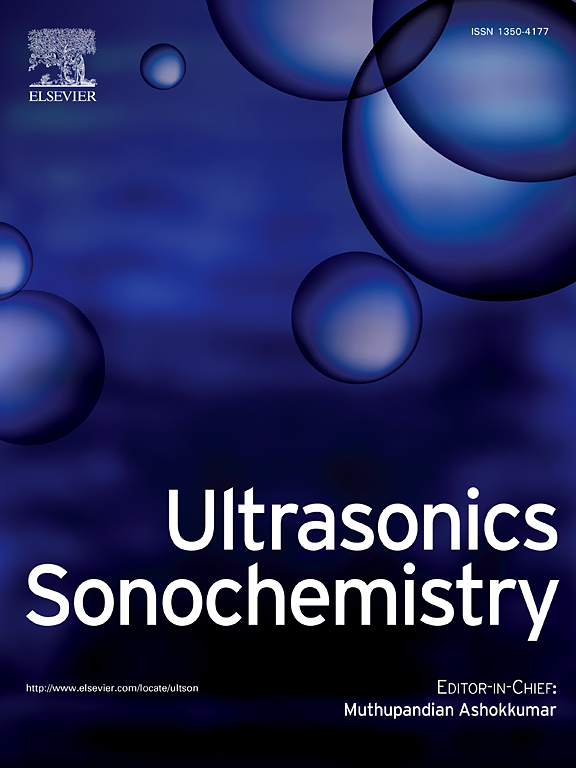Ultrasound-assisted extraction of naringin from Exocarpium Citri Grandis using a novel ternary natural deep eutectic solvent based on glycerol: Process optimization using ANN-GA, extraction mechanism and biological activity
IF 9.7
1区 化学
Q1 ACOUSTICS
引用次数: 0
Abstract
This study aimed to develop an efficient green ultrasound-assisted extraction (UAE) method for naringin (Nar) from Exocarpium Citri Grandis (ECG) using a glycerol-based ternary natural deep eutectic solvent (NADES) and explore its biofunctional relevance. After screening and single-factor optimization, the optimal NADES was identified as glycerol:malic acid:propanedioic acid (1:1:2 M ratio, 30 % water content). Extraction conditions (liquid–solid ratio, temperature, time) were optimized via response surface methodology (RSM) and an artificial neural network-genetic algorithm (ANN-GA), with ANN-GA demonstrating superior predictive capability. Optimal parameters (57 °C, 25.9 mL/g, 24.4 min) yielded a high Nar extraction yield of 175.30 ± 2.94 mg/g. Scanning electron microscopy (SEM) revealed structural changes in ECG, while extraction kinetics indicated an activation energy of 40.45 kJ/mol and molecular dynamics simulations elucidated improved solvation mechanisms. NADES was reusable for at least three cycles before efficiency decreased significantly at the fourth reuse. Furthermore, the extracted Nar showed significant inhibitory activity against key enzymes, with IC50 values of 19.6 μg/mL (α-glucosidase), 2.73 mg/mL (pancreatic lipase), and 1,086 μg/mL (acetylcholinesterase). These results indicate its potential for hypoglycemic, hypolipidemic, and anti-Alzheimer’s therapeutic effects. This work establishes a sustainable strategy for efficient Nar extraction, integrating green solvent technology with bioactivity assessment to advance its therapeutic potential.
基于甘油的新型三元天然深共熔溶剂超声辅助提取柑桔皮苷:ANN-GA工艺优化、提取机理及生物活性研究
本研究旨在建立一种基于甘油的三元天然深共熔溶剂(NADES)从Exocarpium Citri Grandis (ECG)中提取柚皮苷(naringin, Nar)的高效绿色超声辅助提取方法,并探讨其生物功能相关性。经筛选和单因素优化,确定最佳NADES为甘油:苹果酸:丙二酸(1:1:2 M比,30%含水量)。通过响应面法(RSM)和人工神经网络遗传算法(ANN-GA)对提取条件(液固比、温度、时间)进行优化,ANN-GA具有较好的预测能力。最佳提取条件为:57°C, 25.9 mL/g, 24.4 min, Nar提取率为175.30±2.94 mg/g。扫描电子显微镜(SEM)显示了其结构变化,萃取动力学表明活化能为40.45 kJ/mol,分子动力学模拟表明溶剂化机制有所改善。NADES至少可重复使用三次,但在第四次重复使用时效率显著下降。此外,提取的Nar对关键酶的IC50分别为19.6 μg/mL (α-葡萄糖苷酶)、2.73 mg/mL(胰脂肪酶)和1086 μg/mL(乙酰胆碱酯酶),具有显著的抑制活性。这些结果表明它具有潜在的降糖、降血脂和抗阿尔茨海默病的治疗作用。本研究建立了高效提取Nar的可持续策略,将绿色溶剂技术与生物活性评估相结合,以提高其治疗潜力。
本文章由计算机程序翻译,如有差异,请以英文原文为准。
求助全文
约1分钟内获得全文
求助全文
来源期刊

Ultrasonics Sonochemistry
化学-化学综合
CiteScore
15.80
自引率
11.90%
发文量
361
审稿时长
59 days
期刊介绍:
Ultrasonics Sonochemistry stands as a premier international journal dedicated to the publication of high-quality research articles primarily focusing on chemical reactions and reactors induced by ultrasonic waves, known as sonochemistry. Beyond chemical reactions, the journal also welcomes contributions related to cavitation-induced events and processing, including sonoluminescence, and the transformation of materials on chemical, physical, and biological levels.
Since its inception in 1994, Ultrasonics Sonochemistry has consistently maintained a top ranking in the "Acoustics" category, reflecting its esteemed reputation in the field. The journal publishes exceptional papers covering various areas of ultrasonics and sonochemistry. Its contributions are highly regarded by both academia and industry stakeholders, demonstrating its relevance and impact in advancing research and innovation.
 求助内容:
求助内容: 应助结果提醒方式:
应助结果提醒方式:


